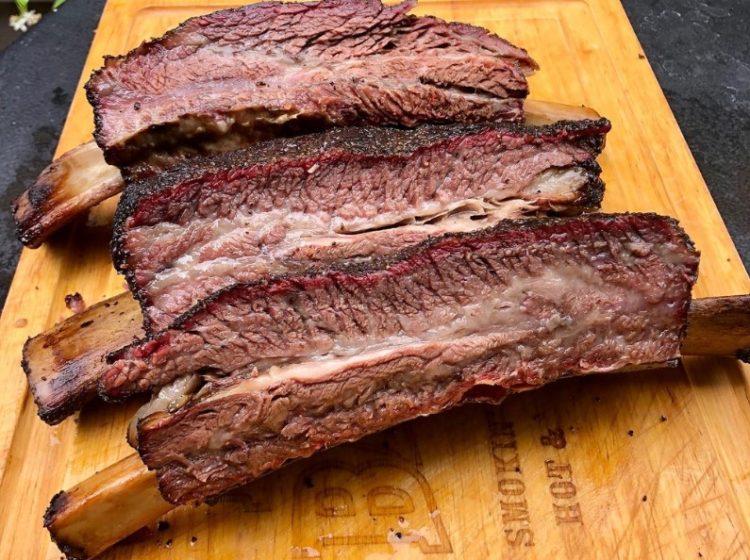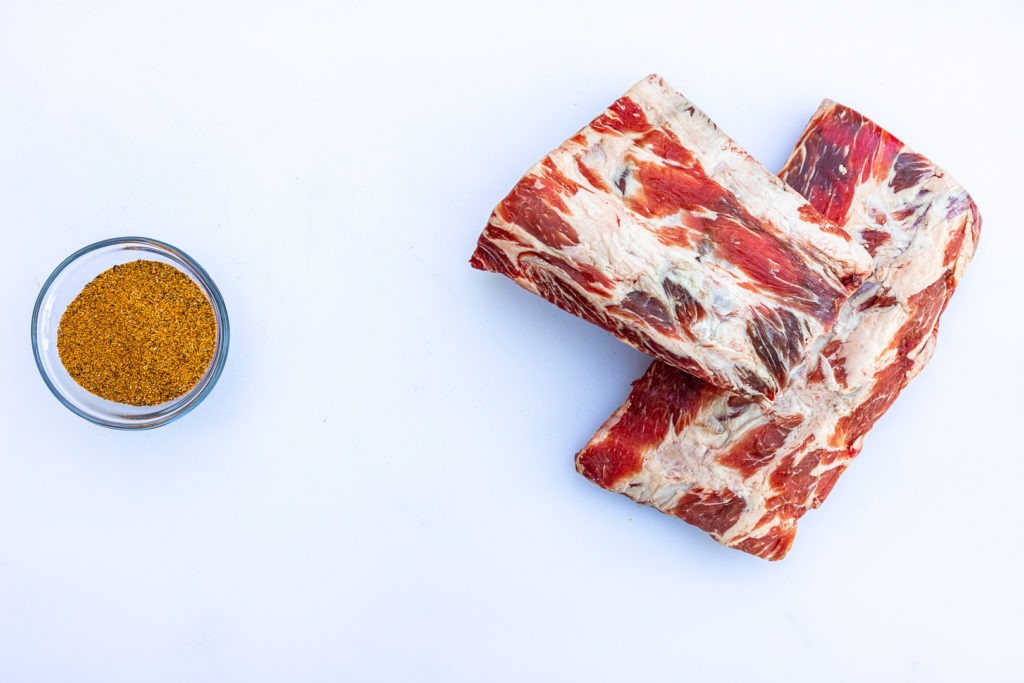Beef ribs can be an incredibly delicious and satisfying meat to cook at home. When done right, they are fall-off-the-bone tender with rich, beefy flavor. However, it’s important to cook them properly, paying close attention to temperature, in order to achieve the best results. Keep reading to find out exactly what temperature you need to cook beef ribs to.
An Overview of Beef Ribs
There are two main types of beef ribs
-
Back ribs – These ribs are cut from the upper rib section near the spine They are longer and flatter compared to other beef rib cuts. Back ribs tend to be lean since they come from a prized area near the ribeye.
-
Short ribs – Short ribs come from the belly/plate section They contain more fat and connective tissue Short ribs have a thicker cap of meat on top of the bones,
Beef ribs need prolonged cooking with moist heat to break down connective tissues and fat to become tender. The collagen melts into delicious gelatin during the cooking process.
Back ribs will generally cook faster than short ribs since they contain less collagen. Short ribs require more time for the collagen to fully transform and meat to get succulent.
Why Paying Attention to Temperature Matters
Cooking ribs to the proper internal temperature is crucial for ideal doneness. Undercooked ribs will be tough and chewy. Overcooked ribs turn out dry and stringy.
The temperature allows the collagen to melt for tenderness and fat to render for flavor. If you rely on cook times alone, it’s easy to over or undercook since ribs can vary in size and composition.
Using an instant read thermometer like the Thermapen or a leave-in probe thermometer like the Smoke X2 takes the guesswork out of determining doneness. They provide a precise temperature reading so you know exactly when ribs are done to perfection.
Recommended Internal Temperatures for Beef Ribs
There are a few key temperatures to pay attention to when cooking beef ribs:
-
145°F (63°C) – The USDA recommends cooking beef to at least 145°F for food safety. At this point, any harmful bacteria have been eliminated. However, ribs will still be quite tough at this temp.
-
160°F (71°C) – Collagen begins breaking down, slowly starting to melt into gelatin. Ribs are becoming more tender but still need more time.
-
203°F (95°C) – The ideal final internal temperature for tender, fall-off-the-bone beef ribs. Meat should easily pull clean from the bones.
Beef ribs are safe to eat starting at 145°F but won’t be fully tenderized until around 200-203°F when collagen fully converts to gelatin. For the best texture and flavor, target removing ribs from heat at 203°F.
Tips for Measuring Temperature of Beef Ribs
Use an instant read thermometer like the Thermapen Mk4 or Thermapen One to check temperature. For larger cuts like ribs, insert the probe into the thickest part of the meat, avoiding bone.
For grill or smoker, leave a probe in the entire time with a wireless thermometer like the Smoke X2 or Smoke X4. The cable threads through the lid so you can monitor it without opening the grill.
The “stall” around 160-170°F is normal as collagen breakdown occurs. Temperature will plateau until the collagen fully melts. Be patient and let ribs cook until reaching around 200°F.
When done, the probe should slide in and out of ribs easily. Meat should start separating from the bone. Double check doneness with an instant read thermometer before removing from heat.
Recommended Cooking Temperatures and Times
To achieve tender, juicy beef ribs, use these cooking temperatures and times as a guide:
- 225°F (107°C) – 6-8 hours
- 250°F (121°C) – 4-6 hours
- 275°F (135°C) – 3-4 hours
- 300°F (149°C) – 2-3 hours
- 325°F (163°C) – 1.5-2 hours
- 350°F (177°C) – 1-1.5 hours
The time ranges account for differences between back vs short ribs. Short ribs need more time at a given temperature.
Higher heat will reduce total cooking time but you risk drying out the exterior before the interior is fully cooked. Lower and slower is ideal for breaking down collagen.
Regardless of cooking temp, always rely on a thermometer to determine when ribs have reached the proper internal temperature.
Step-By-Step Guide to Cooking Beef Ribs
Follow this simple process for foolproof results:
-
Remove membrane – Trim off the thin silverskin membrane from the bone side of ribs. This must be removed prior to cooking.
-
Season ribs – Use a dry rub or apply a sauce later. Generously season ribs all over.
-
Select cooking method – You can smoke, grill, roast, or braise beef ribs. Choose a method based on your time constraints and equipment.
-
Cook at low temp – Ideal pit temperature for smoker or oven temp for roasting is 225-250°F. This gives collagen time to melt.
-
Monitor internal temp – Insert a leave-in thermometer probe into thickest part of meat. Remove ribs once they reach 200-203°F.
-
Rest 5-10 minutes – Final internal temp will rise 5-10°F as ribs rest. This prevents overcooking.
-
Serve and enjoy – Slice into individual ribs if needed. Dig into these tender, beefy ribs!
Take your time and let the low, slow cooking work its magic. Your patience will be rewarded with insanely delicious, fall-off-the-bone beef ribs!
Frequently Asked Questions
What if I don’t have a thermometer?
It’s highly recommended to use a thermometer when cooking any type of meat to eliminate guessing doneness. For ribs, it’s the only reliable way to know precisely when they are perfectly cooked.
Should I wrap or foil the ribs during cooking?
Wrapping or foiling ribs partway through is optional. It helps steam and tenderize the meat. Cook for at least 2 hours unwrapped, then wrap in foil and continue cooking until ribs reach 200°F.
Can I reheat leftover beef ribs?
Yes! Store leftover cooked ribs in the fridge up to 4 days. Reheat gently in a 250°F oven until warmed through, about 20 minutes. You can also reheat in the microwave but keep time short to avoid overcooking.
What wood is best for smoking beef ribs?
Good all-purpose wood choices are oak, hickory or pecan. Avoid very strong woods like mesquite on beef ribs, which can overpower the flavor. Fruit woods like apple, cherry or peach also pair nicely with beef.
What rib cut should I choose?
For more meat, choose bone-in short ribs. For leaner and quicker cooking, opt for back ribs. Talk to your butcher about options. Short ribs will require more time to become tender but give the most meat per bone.
How can I tell when ribs are done without a thermometer?
There’s no good way besides using a thermometer. You can try the bend test, but connective tissue doesn’t breakdown the same as pork ribs. Relying on time alone isn’t reliable either. Only temperature provides doneness accuracy.
Conclusion
For incredible beef ribs every time, cook low and slow while monitoring internal temperature. Allow ribs to reach around 200-203°F for tender, fall-off-the-bone texture with rich, beefy flavor. Remove ribs promptly once they hit the ideal internal temperature. Rest briefly before serving. Use a thermometer for perfect doneness and enjoy your fantastic homemade beef ribs!

How to find beef back ribs?
When your butcher makes a boneless prime rib roast or a tray of ribeye steaks, these are the ribs she cuts off. And that, in turn, proves to be their one difficulty: they are not always readily available. Most butcher’s shops only have as many racks of back ribs on hand as they have from their cutting. Calling ahead to a butcher shop or meat counter can ensure they have some on hand for you. Just be sure to specify you want back ribs, not short ribs. You are fortunate indeed if you are able to score a full, uncut rack of these tasty morsels—they are often cut into partial racks of 3-5 ribs. Now, there’s nothing wrong with partial racks—they cook up just fine—but if you want full racks, be sure to call your butcher a day or two ahead of time.

Aaron Franklin’s Beef Ribs
- 1 (3- to 5-pound) rack of beef short ribs (from the plate, not the chuck)
- 1 tablespoon hot sauce, such as Cajun Chef or Crystal
- About 1/3 cup to 1/2 cup Brisket and Beef Rib Rub
- Spray bottle of water, vinegar, or other liquid
- Seasoned firewood (preferably oak or hickory)
- Equal parts 16-mesh ground black pepper and kosher salt
- Heat the smoker to 285°F and check that the water pan is full.
- Trim the ribs if needed.
- Slather the ribs with a very light coating of hot sauce.
- Apply the rub (equal parts salt and black pepper).
- Cook the ribs, meat side up, at 285°F, for about 8 to 9 hours.
- Spritz during the final 2 to 3 hours.
- Check for doneness by poking the ribs; when they feel like melted butter (about 203°F between the bones), serve.
Get a fire going and heat the smoker so it’s about 285°F at grate level.
Beef ribs usually come quite clean and well-trimmed, unlike pork ribs and briskets, so there’s not much to do. If you see any big chunks or flaps of fat, trim them away. Apart from that, I don’t trim beef ribs.
When I’m cooking for myself, I like to slather the ribs with a bit of hot sauce. Of course, you can slather with anything you like—from water to mustard to vinegar. The slather is mainly there to help the rub adhere to the surface of the meat. I just think a little hint of earthy spiciness from a bottle of hot sauce is a fun addition to beef ribs. You can’t really taste it in the final product, but it helps build interior layers of flavor.
Using a shaker, and holding it 1 to 2 feet above the ribs, generously apply the rub—a little heavier than you would on a brisket. This is because, as rich as brisket is, beef ribs are even richer. The extra rub ends up forming a bark that balances out that richness just a little bit. I generally use somewhere around 1/3 to 1/2 cup of rub for each rack of beef ribs.
Place the ribs, meat side up, in the smoker. As usual, I cook meat side up because I’ve determined that my smokers have more topside heat and the meat and fat cap can handle that. If you’ve got more heat coming from below, you might consider going meat side down. Again, it’s up to you—the ribs can come out well either way. Cook for 8 to 9 hours, until done.
During the final 5 hours or so, spritz pretty frequently with water or other liquid to keep the ends from burning.
Check for doneness by gently inserting a toothpick between two membranes: the one outside the bones and the one that separates the bones from the meat. Inside, the meat should be extremely tender. Alternatively, take an internal temperature reading: the ribs should be done when they reach 203°F. Let them rest for at least 30 minutes before serving. Beef ribs are served on the bone, but great for sharing.
Plus exclusive recipes, travel recs and unique videos– all sent to your inbox! Sign up for my Spilled Milk newsletter. Once subscribed, check your email for the free download.- AZ
